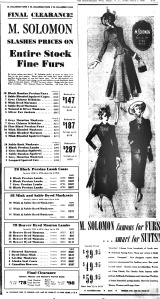Albany’s fortune was founded on the fur trade in the early 1600′s. There was an abundance of beaver, highly sought after for fashionable beaver hats in Europe. So much so that Albany was incorporated as “Beverwyck” (loosely translates from Dutch to “Beaverville”) in 1652 . By the early 1900′s, however, the beaver population had been harvested in New York State almost to the point of extinction.
It was about that time that the middle class, with disposable income, began to grow. Fur coats become status symbols as a result of silent films. Glamorous films stars wore fur on and off screen. There was nothing more chic than a fur, except for a diamonds. Furs were aspirational Albany women were no exception The demand for fur coats increased. Sable and mink were far too expensive for most consumers, so other furs were used. Raccoon coats caught on, especially among students on college campuses. The raccoon coat is the iconic symbol of the roaring ’20s. And then came the Depression .
Women still wanted fur coats .. symbols of sex and glamour, but they were also practical. Nothing was warmer in the harsh northeast winters. While the financial crisis had an impact in Albany, it and the surrounding areas were not devastated. As the State Capital, it had many government workers. Federal money flowed into the home state of Roosevelt and the city in which he had lived for so many years while he was in the State Legislature and the Executive Mansion. The demand for fur flourished.
There were dozens of furriers in Albany in the 1930′s – many of whom had been plying their trade for generations in the city, but most were foreign born – immigrants who migrated here in the late 19th and early 20th centuries from Europe and Russia. They had skills and talent. So they turned to other furs. ”Jap Mink” fur coats were a hot commodity in the 1930’s. Japanese mink is actually a form of light colored weasel with a bushy thick coat that could be dyed to mimic natural mink. Seal skin was water repellent, great for snowy winters, but doesn’t have a lush pelt. Fox was a popular, less costly fur, as was squirrel. But one thing Albany did have was muskrats. Muskrats galore; an embarrassment of muskrats. (And still has, even today.) Muskrat pelts were durable and fairly waterproof. And in the Depression, there were plenty of people willing to trap the wily muskrat for extra money.
Then came World War II, and no one wanted to buy “Jap” anything. With so many more women working, and with larger incomes, fur coats were still in great demand. And muskrats still ruled in Albany. Local furriers ran ads everyday offering to pay the “highest prices” for muskrat skins.
After the War ended, women still wanted to buy fur; throughout the late 40’s and into the early 1950’s. But by the middle of the 1950’s, demand in general, and in Albany in particular, dropped. Dior’s “New Look”, launched in 1947 meant fuller, longer skirts with a nipped, defined waist. Even the best furriers found it difficult to tailor fur coats for these clothes. When they did, they were expensive. And women now wanted mink.. mink anything.
The day of the Muskrat was over – even in Albany.
1928
1933
1934
1932
1933
1941
1943
1945
1947
1949
1950
1951













